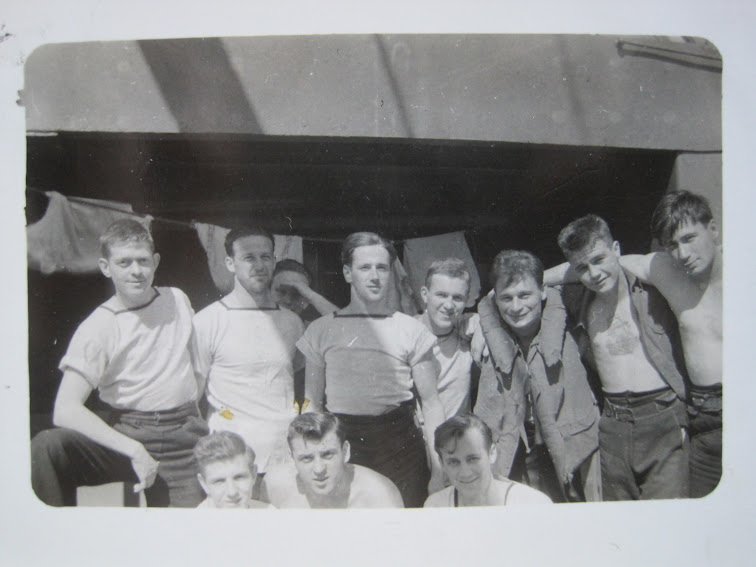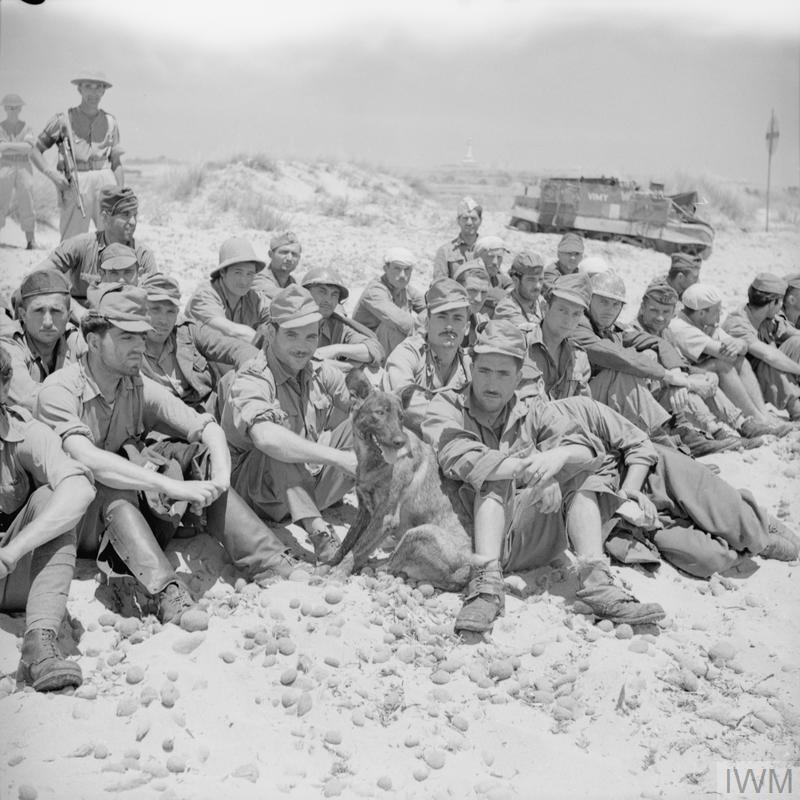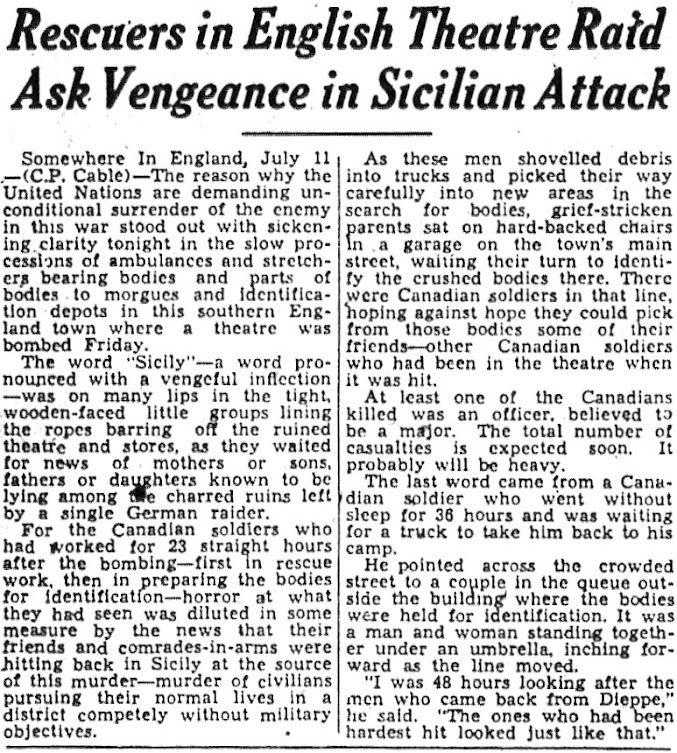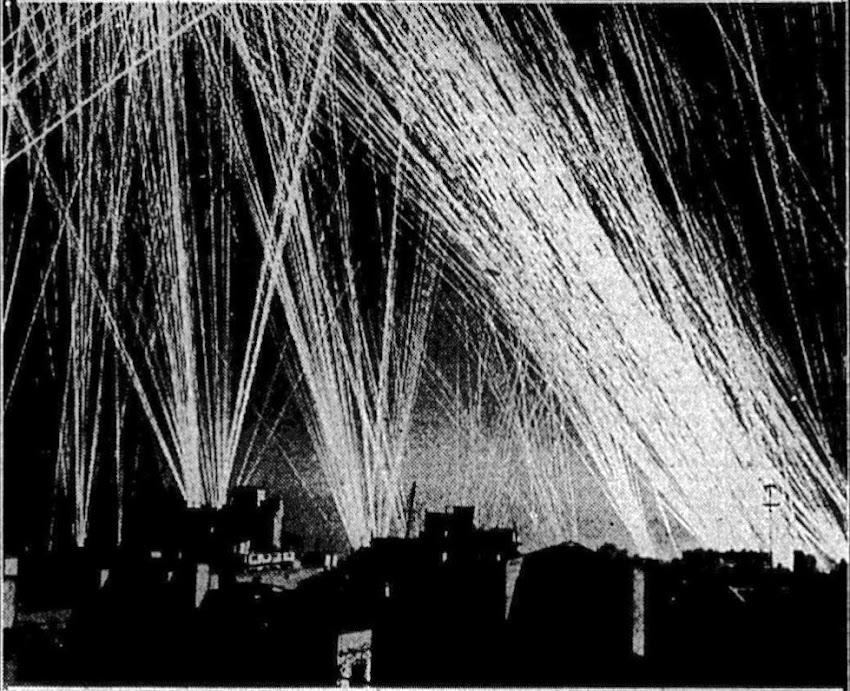Much Has been Written about 'The Savoy' (Cave) But...
The Exact Location is Still a Bit of a Mystery
Hiking trails south of GEORGE Beach are well marked.
But should I be going north of there? (AllTrails.com)
Introduction:
I am certain I will be able to stand upon the beaches where the 80th Flotilla of Canadian Landing Craft served (of which my father - RCNVR/Combined Ops - was a member) during the invasion of Sicily (Operation Husky), beginning July 10, 1943. When I visit Sicily this summer I will be staying in the city of Avola, about 10 km to the south of the Punta del Cane peninsula pictured above, and will be just a short train ride away from GEORGE Beach at modern day Fontane Bianche.
And after standing on and exploring the beaches I will likely say to myself, "Okay. Now, where is the cave he lived in for 2 - 3 weeks - with about 50 other sailors - and fondly called 'The Savoy'? I can see the peninsula to the south (about 1 km) and the hiking trails on the closest side are easily found. Let's go!!"
All the while I'll be aware that if I have no luck to the south I can always go north the next day. I lean toward the south because it looks more pastoral in photos and maps I've found and the cave had been used to house cattle (to escape the heat) before my father and mates bedded down and cooked their meals in the relative safety of the 'lizardly' cave.
Below I share several pieces of information about the cave as recalled by my father and others who enjoyed its safety and 'atmosphere.' No photos accompanied any of the written descriptions I have located thus far.
The first references to the cave inhabited by men of the 80th Flotilla (5 - 6 miles south of Syracuse and approx. same distance north of Avola) are found in a 13-page report by Lt. Cdr. J. E. Koyle (DSC, RCNVR) as found in the book "Combined Operations" by Londoner Clayton Marks, pages 173 - 185.
The first references to the cave inhabited by men of the 80th Flotilla (5 - 6 miles south of Syracuse and approx. same distance north of Avola) are found in a 13-page report by Lt. Cdr. J. E. Koyle (DSC, RCNVR) as found in the book "Combined Operations" by Londoner Clayton Marks, pages 173 - 185.
Life Ashore -
The conditions for men ashore off duty varied. The 81st Flotilla Officer, Lieutenant Mullins, went ashore on the second day (@HOW Sector), after a day of ferrying high octane gas through air attacks, and managed to arrange with the Army for the billeting and feeding of his men at a rough camp about three minutes walk from the beach. The 80th did not fare so well and had to fend for themselves (@GEORGE Sector). They found, after living and feeding from ship to ship until the 21st of July, a cattle cave near the beach, which provided shelter but was uncomfortable and dirty. Both Flotillas lived mainly from Army "Composite" rations and what meals they could get from merchant ships they were unloading.
However, there were compensations. After things settled down, there were frequent opportunities for visiting nearby Sicilian towns, and sampling (to say the least) the local wine, Vino. Leave expeditions were organized to Noto (15 kilometres away) and to Syracuse, where the Canadians patronized the Fascist Armoury which contained all manner of war trophies... (page 181) After resting and repairing LCMs in Malta the 80th returned to action, i.e., the invasion of Italy, Operation Baytown. The ferrying job across the Messina Straits went on for thirty-two days (beginning Sept. 3) with much the same sort of discomfort as had been experienced south of Syracuse, but the organization was rather better and Flotillas were usually able to operate as a team instead of as individual craft with better results.
At their camp near Messina the Flotillas were better off than in their cave on "GEORGE" beaches, but supplies of all kinds were still hard to get, and medical services in particular were badly strained. The Flotilla personnel were in worse shape than at any time since the operations commenced and sores developed from the slightest scrape. The Flotilla ran their own Sick Bay under the charge of a Duty Officer and sores were dressed as well as amateurs could do it... page 184.
The conditions for men ashore off duty varied. The 81st Flotilla Officer, Lieutenant Mullins, went ashore on the second day (@HOW Sector), after a day of ferrying high octane gas through air attacks, and managed to arrange with the Army for the billeting and feeding of his men at a rough camp about three minutes walk from the beach. The 80th did not fare so well and had to fend for themselves (@GEORGE Sector). They found, after living and feeding from ship to ship until the 21st of July, a cattle cave near the beach, which provided shelter but was uncomfortable and dirty. Both Flotillas lived mainly from Army "Composite" rations and what meals they could get from merchant ships they were unloading.
However, there were compensations. After things settled down, there were frequent opportunities for visiting nearby Sicilian towns, and sampling (to say the least) the local wine, Vino. Leave expeditions were organized to Noto (15 kilometres away) and to Syracuse, where the Canadians patronized the Fascist Armoury which contained all manner of war trophies... (page 181) After resting and repairing LCMs in Malta the 80th returned to action, i.e., the invasion of Italy, Operation Baytown. The ferrying job across the Messina Straits went on for thirty-two days (beginning Sept. 3) with much the same sort of discomfort as had been experienced south of Syracuse, but the organization was rather better and Flotillas were usually able to operate as a team instead of as individual craft with better results.
At their camp near Messina the Flotillas were better off than in their cave on "GEORGE" beaches, but supplies of all kinds were still hard to get, and medical services in particular were badly strained. The Flotilla personnel were in worse shape than at any time since the operations commenced and sores developed from the slightest scrape. The Flotilla ran their own Sick Bay under the charge of a Duty Officer and sores were dressed as well as amateurs could do it... page 184.
(My father and a mate closed up Sick Bay early one day when two pregnant women came for a bit of help. GH)
Lt. Cdr. Koyle's full report can be found on my site "1000 Men 1000 Stories" in four parts (the pieces I referenced are in Part 3).
As of this writing, I located a news article approx. 2 months ago in The (Montreal) Gazette in which both Koyle and Mullins are mentioned, as was the cave and its location relative to the beaches being serviced by the 81st Flotilla. "To the north" is all I can recall re the cave, which doesn't help me much now, because hiking trails to the north and south of Fontane Bianche would both be "to the north" of the HOW Sector (or Beaches) served by the 81st Flotilla. The article is currently on a USB stick with about 30 other newspaper issues... so it will be shared soon, I hope.
As of this writing, I located a news article approx. 2 months ago in The (Montreal) Gazette in which both Koyle and Mullins are mentioned, as was the cave and its location relative to the beaches being serviced by the 81st Flotilla. "To the north" is all I can recall re the cave, which doesn't help me much now, because hiking trails to the north and south of Fontane Bianche would both be "to the north" of the HOW Sector (or Beaches) served by the 81st Flotilla. The article is currently on a USB stick with about 30 other newspaper issues... so it will be shared soon, I hope.
Next, an excerpt from my father's story, "Cool, Damp, Safe Rooms at The Savoy," follows (italics mine):
The cave itself had been used at some time to house cattle to protect them from us. It was large enough to sleep many more. The roof was 70 or 80 feet thick and supported by huge limestone pillars inside.
“The cave was large enough to sleep many more” Photo - Palermo91
We soon obtained a barrage balloon (the same way I got the rum) which we anchored on top of the cave. Unless a bomb dropped in front of the door, we were as safe as a church. There wasn’t a bomb as yet that could pierce that roof.
The limestone underfoot was almost like wet cement, but we happily trudged through this, put our hammocks down doubled up, laid our mattresses on them, curled up in our blankets clothes and all, and slept like logs. We even recessed navy lamps into the walls. The ceiling was about 20 feet high. It was cool, damp and safe and we shared our good fortune with several little green lizards who had cool feet.
Early each morning we paraded out and slung our sleeping gear over bushes or on the lower limbs of olive trees and they would be quite dry by night. We decided to free one sailor from duty and he was to take over as a cook, something we just didn’t have. The cook’s duties were to find food and cook it in a huge metal cauldron, which we had procured in the same way as the rum and barrage balloon.
The cauldron was raised on stones and heated by pouring gasoline on the limestone underneath. This worked out quite well. The cook scrounged tomatoes (pomadori) which were plentiful and we managed some bully beef (the same way as rum, barrage balloon and cauldron). This was all stirred up together and one night we had tomatoes and bully beef, and the next night we had bully beef and tomatoes. Once in a while we threw in a sea boot to add a little flavour.
Although we were like a bunch of orphans, spirits always remained high. There were hundreds of cleverly contrived anti-personnel bombs about, but we and the cook were well-schooled on these. Field Marshall Montgomery spoke highly of the Canadian flotillas through the British Admiralty and said he was glad to have us along. After about 38 days, the Army and Air Force had won the day and Sicily was freed. Our work was done.
Our commanding officer, Lt./Cdr. Koyl gave us the news and said we could now return to Malta and prepare for Italy. In our glee someone shot down the barrage balloon and we said goodbye to the cave, which we had nicknamed The Savoy.
In my opinion, the above story is littered with clues that will assist me in my search. For example, the cave should still be "a huge hump in the beach landscape." It should still be "large enough for about 60 sailors to sleep there, or more." There should be access to its entrance in order to "house cattle" and "the roof was 70 or 80 feet thick and supported by huge limestone pillars inside."
Other clues followed the ones I have mentioned, making me think of pastoral surroundings ("tomatoes (pomadori)... were plentiful) and plentiful "anti-personnel bombs" had been buried in the earth.
About the nickname 'The Savoy.' Surely a few of the sailors still had their Navy knives with 4-inch spike. (Many sailors had likely traded away their knives for fruits and vegetables and clean water during the lengthy trip aboard the SS Silver Walnut around Africa on their way to Sicily.)
What in the world would sailors use these items for, I wonder?
[Note to Self: Take sturdy shoes, a flashlight, dark pencil and tracing paper - for rubbings]
Questions or comments about the voyage of the SS Silver Walnut? Readers can connect by email with Editor at gordh7700@gmail.com
From the collection of Doug Harrison. Initially he did not like the 'Walnut'
at all. His opinion greatly changed after arriving in Port Said, Egypt safely.
Canadian sailors Joe Malone (left) and Doug Harrison working on
their tans aboard Silver Walnut. From the Norwich Gazette, 1995
Now, back to 'the cave.'
On page 182 Lewis shares a story entitled "Airborne Mishaps Off the Sicilian Coast" in which we read the attached three paragraphs:
The other reference is found on page 193 in the short story "Miss Canada" LCM 1022, 80th Flotilla:
Chuck Rose, Ted Sale, John Rimmer and others arrived in Port Said (after their trip around Africa) aboard HMS Keren. They appear with other members of the 80th Flotilla of Canadian landing crafts in the photo below (from the collection of Doug Harrison):
I'll add one last brief reference to the caves by Lloyd Evans, (RCNVR, Combined Ops) originally from Ottawa, and living in Markham, ONT when I met him a few years ago. He had his memoirs in a book as I did re my father's (we traded one another and discovered each book contained a photo in which the other appeared!). I came out the winner, I believe. Lloyd's son sent me his father's WWII photo collection after Lloyd passed away.
[I would add here that one of the challenging aspects of connecting with my father's mates via their kin is that I am often reminded that the sailors are gone, their stories are mostly gone if not written down (which is generally the case), their wives are gone. Their loss is our generation's great loss. "Oh, if we'd only talked to them more often - or shown some genuine interest in their experiences - when they were alive." "Such is life," as my father would say.]
I cannot link you to Lloyd's book, but his memoirs appear on a website re Comb. Ops by Scotsman Geoff Slee. (And that's how I found Lloyd, through Geoff, both kindred spirits).
Lloyd's reference from 'My Navy Chronicles' follows:
After we finished unloading our mother ship, it sailed off and we moved onto the beach. There was still plenty of work unloading supplies from other ships in the area. Good accommodation was hard to find, so we moved into a big cave. It was damp inside, so we put our hammock mattresses on stretchers. Even so they and our blankets were wet through in the mornings and had to be hung out to dry.
Before bedding down at night, we had the ritual of shaking bugs and beetles from our beds. However, these deprivations were better by half than the ever present threat of enemy bombs. Several of our boys picked up an infection and ended up in the hospital with a high fever similar to malaria, although we had all been talking anti-malaria pills.
At one point, Army Intelligence thought the Germans were going to land paratroops to recapture the beach with the aim of cutting off our inland troops from their supplies. We anchored our landing craft off the beach and stayed on them that night instead of sleeping in the cave.
At one point, Army Intelligence thought the Germans were going to land paratroops to recapture the beach with the aim of cutting off our inland troops from their supplies. We anchored our landing craft off the beach and stayed on them that night instead of sleeping in the cave.
The army moved in a group of Indian troops that night with orders to finish off anybody who wasn't wearing a turban! The Indians were excellent at that type of operation but didn't get the chance to show what they could do, since it turned out to be an uneventful night. Perhaps the presence of our Air Force had caused the enemy to think twice about such an attack... our beach was near the town of Avola...
Many of Lloyd's recollections are so similar to my father's that at first I thought they had to be twins or best of mates. Please click here to read Lloyd's full story.
Will I find 'The Savoy?' You'll hear it here first if I do.
More to follow re my upcoming trip to Sicily.
Please click here to read About a Trip to Sicily (2)
Unattributed Photos GH
Will I find 'The Savoy?' You'll hear it here first if I do.
More to follow re my upcoming trip to Sicily.
Please click here to read About a Trip to Sicily (2)
Unattributed Photos GH















































































